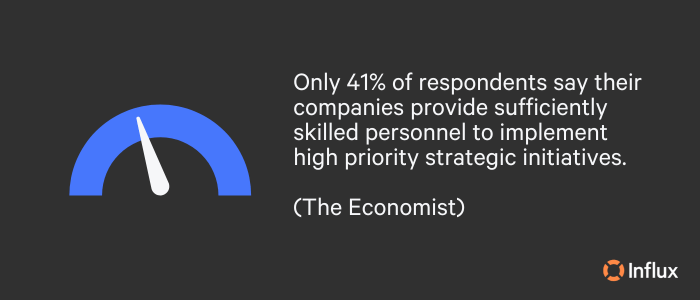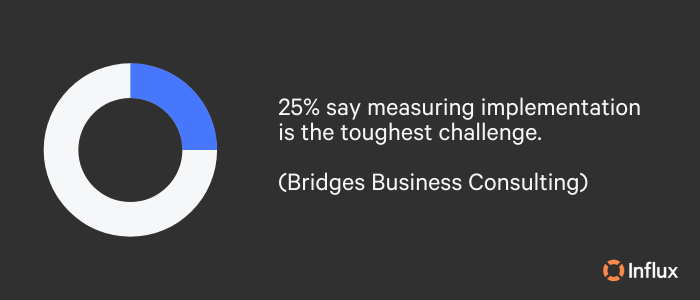Are you looking for customer support assistance? Influx support teams scale with you. Get a quote!
The origins of strategy can be traced back to roughly the 5th century BC when Sun Tzu wrote The Art of War on the importance of battle tactics and preparation. Over time, the concept of strategy evolved beyond military planning and was applied to other areas, including business. Although business and military strategies differ, the central premise stays the same: plans should be calculated and strategic to reduce damage and wasted resources.
Modern business strategy emerged as a practice in the 1960s. Today, strategy is a fundamental concept in business and describes the planning and executing of a long-term vision or goal. When hearing the words ‘business strategy,’ SWOT analysis, competitive advantages, innovation, improving customer support, planning meetings, and a whole lot more come to mind. In the evolution of business strategy, what matters the most now, and what drives the most results?

Business strategy then vs. now
“The world economy is six times larger than it was half a century ago, growing at an annual rate of 4% during the period.” (IMF) Now more than ever, the modern consumer world is abundant with stuff, whereas even a century ago, it was driven by need. The concept of humans as consumers emerged before World War I, but it became commonplace in America in the 1920s. Since then, there has been a profound leap in consumerism and a change in international financial flows.
The rise of consumerism and the mass production of goods caused an increase in business competition that required innovative solutions. Richard Horwath, the founder and CEO of the Strategic Thinking Institute, shares a seven-phase timeline of business evolution. Taking the time to learn about these seven phases helps shape the future of business strategy; as we all know, history repeats itself.
Phase 1: Budgetary Planning (1950 - 1960)
Financial control was established through operating budgets, which included investment planning and project evaluation.
Phase 2: Corporate Planning (1960 - 1968)
Corporate planning is a process businesses use to map out a strategy for growth, increased profits, increased exposure, or strengthened brand identity.
Phase 3: Corporate Strategy (1968 - 1975)
Portfolio planning influenced the adoption of corporate strategy in the 1970s, and large companies needed to establish synergy between business units and corporate parents.
Phase 4: Industry and Competitive Analysis (1975 - 1985)
Firms began to scrutinize their industry selection, markets, segments, and positioning within those segments.
Phase 5: Internal Sourcing of Competitive Advantage (1985 - 1995)
The term ‘core competencies’ was coined by Hamel and Prahalad to represent sources of competitive advantage that focus on a business’s assets and capabilities and how these internal strengths provide an advantage over rivals.
Phase 6: Strategic Innovation and Implementation (1995 - 2001)
Companies that once aimed for long-term competitive advantage have discovered that it no longer exists. The goal now is to identify and capitalize on dynamic sources of competitive advantage that can be used to fund the next wave of innovation.
Phase 7: Strategic Thinking and Simplification (2003 and beyond)
The focus of strategy shifts to strategic thinking and simplification: people learning the tangible skills of strategic thinking and applying them in simple frameworks that allow strategy development to be an ongoing, daily occurrence.
There’s no argument that these different phases didn’t individually influence and expand upon each other to get to where business strategy is now. But consumers have also played a significant role in planning progression that cannot be denied. Shifting consumer expectations and demand is something that businesses have always had to adapt to. With new technology and increased competition, these various aspects of a comprehensive business strategy will continue to layer upon each other without siloing but seamlessly joining and expanding together.
The essential elements in business strategy
Your business strategy is your roadmap for decision-making and guides you toward success. The most critical elements of a business strategy may vary depending on the industry, company size, and specific objectives of your business, but here are some key components that are essential to any business strategy:
1. Customers
If your business were a car, your customers would be the wheels; without them, you aren’t going anywhere. Whether you want to develop new products, scale your operations, or increase sales, customers should be at the forefront of your strategy. Market research helps better understand your customers’ needs, preferences, and behaviors. By involving customers in your business strategy, you build stronger relationships with them and ultimately drive business growth.
2. SWOT analysis
A SWOT analysis is a method for assessing strengths, weaknesses, opportunities, and threats. It helps to identify areas where a business can capitalize on its strengths, address its flaws, and take advantage of opportunities while mitigating potential threats.
3. Competitive analysis
A competitive analysis examines your competitors’ features, market share, pricing, marketing, differentiators, strengths, weaknesses, geography, culture, and customer reviews. This analysis will help identify ways to differentiate from competitors and gain a competitive advantage.

4. Marketing and sales strategy
Your marketing strategy is a part of your business strategy because it provides a game plan to promote products and services to your target market and converts potential customers into paying customers. Marketing strategies should revolve around your value proposition.
5. Financial plan
Financial planning is an integral part of your business strategy because it keeps you on track as the company grows. It also helps to allocate resources effectively and make informed financial decisions. Understanding and planning your expenses includes budgeting, revenue projections, and other goals you aim to achieve.
6. Implementation plan
Your implementation plan should outline the specific steps and timeline for implementing your business strategy. It should include clear action items, deadlines, and responsible parties.
7. Monitoring and evaluating
Regularly monitor and evaluate the effectiveness of your business strategy and make adjustments as needed. From a data and results-driven perspective, monitoring performance will help to keep your team on track.

Scale with customer support solutions
We understand that many aspects of your business need your budget and attention. This is why we aim to keep our solutions economical and superior to alternatives. Your customers deserve only the best of the best. Scale with Influx for increased customer satisfaction and enhanced customer experiences. Stay flexible and get a quote now.

